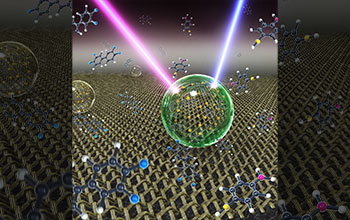Multimedia Gallery
New ultrasensitive detection platform
An artistic illustration showing an ultrasensitive detection platform called SLIPSERS -- slippery liquid infused porous surface-enhanced Raman scattering. An aqueous or oil droplet containing gold nanoparticles and captured analytes is allowed to evaporate on a slippery substrate, leading to the formation of a highly compact nanoparticle aggregate for surface enhanced Raman scattering detection.
More about this image
Researchers at Penn State have developed a new technique that combines the ultrasensitivity of surface-enhanced Raman scattering (SERS) with a slippery surface. The technique will make it feasible to detect single molecules from a number of chemical and biological species, whether gaseous, liquid or solid. This combination of slippery surface and laser-based spectroscopy will open new applications in analytical chemistry, molecular diagnostics, environmental monitoring and national security.
The research was funded by a U.S. National Science Foundation Faculty Early Career Development (CAREER) program award (grant CMMI 1351462).
Learn more in the Penn State news story Single molecule detection of contaminants, explosives or diseases now possible. (Date image taken: December 2015; date originally posted to NSF Multimedia Gallery: July 12, 2016)
Credit: Shikuan Yang, Birgitt Boschitsch Stogin and Tak-Sing Wong, The Pennsylvania State University
Images and other media in the National Science Foundation Multimedia Gallery are available for use in print and electronic material by NSF employees, members of the media, university staff, teachers and the general public. All media in the gallery are intended for personal, educational and nonprofit/non-commercial use only.
Images credited to the National Science Foundation, a federal agency, are in the public domain. The images were created by employees of the United States Government as part of their official duties or prepared by contractors as "works for hire" for NSF. You may freely use NSF-credited images and, at your discretion, credit NSF with a "Courtesy: National Science Foundation" notation.
Additional information about general usage can be found in Conditions.
Also Available:
Download the high-resolution JPG version of the image. (4.1 MB)
Use your mouse to right-click (Mac users may need to Ctrl-click) the link above and choose the option that will save the file or target to your computer.

